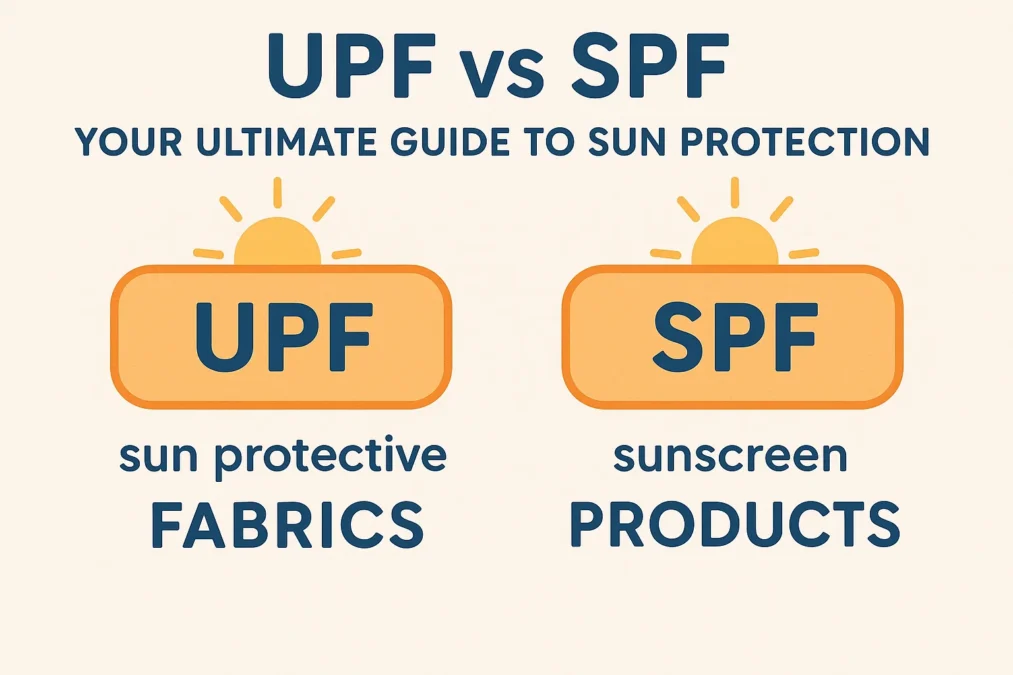UPF vs SPF: You slather on sunscreen before a day at the beach, diligently checking the bottle for a high SPF number. But have you ever stopped to consider the shirt you’re pulling on over it? For decades, sunscreen has been the undisputed champion of sun safety, but a powerful ally has emerged in the fight against harmful UV radiation: UPF clothing. Understanding the difference between UPF and SPF is crucial for building a comprehensive and effective sun protection strategy. It’s not about choosing one over the other; it’s about understanding how they work in harmony to shield your skin from the sun’s damaging rays. This guide will demystify these acronyms, break down the science in simple terms, and empower you to make smarter choices for your long-term skin health. Think of it as learning the unique strengths of your favorite dynamic duo—Batman and Robin, but for your skin.
The sun emits ultraviolet (UV) radiation, which is invisible to the human eye but has very visible effects on our skin. This radiation is categorized mainly into UVA and UVB rays. UVA rays are the aging rays, penetrating deep into the skin to cause long-term damage like wrinkles and loss of elasticity. UVB rays are the burning rays, primarily affecting the skin’s surface and causing sunburn. Both types play a significant role in developing skin cancer. This is where our two heroes, UPF and SPF, come into play. They are both ratings designed to measure protection, but they apply to completely different things and are tested in vastly different ways. Grasping this distinction is the first step toward truly effective sun safety.
What is SPF? Decoding the Sunscreen Standard
SPF, or Sun Protection Factor, is a measure of how well a sunscreen will protect your skin from UVB rays, the kind that cause sunburn and can contribute to skin cancer. The number itself is a multiplier. For example, if your skin would normally start to burn after 10 minutes in the sun without any protection, an SPF 30 sunscreen theoretically provides 30 times that—or about 300 minutes of protection before burning begins. However, this is a laboratory ideal. In reality, sweat, water, sand, towel drying, and simply not applying enough product drastically reduce its effectiveness. It’s a crucial tool, but it has its limitations and requires diligent, repeated application to work as intended.
The SPF number primarily indicates protection against UVB rays, but broad-spectrum sunscreens are also designed to protect against UVA rays. When you see “broad-spectrum” on a label, it means the product has passed tests proving it protects against both types of harmful radiation. It’s also important to understand that SPF protection is not linear. SPF 30 blocks about 97% of UVB rays, while SPF 50 blocks about 98%, and SPF 100 blocks about 99%. No sunscreen can block 100% of UV rays. The higher numbers offer marginally better protection, but the key is proper and generous application. Most people apply only 25-50% of the recommended amount, which drastically reduces the effective SPF they are getting.
What is UPF? The Fabric of Sun Defense
UPF, which stands for Ultraviolet Protection Factor, is the rating system used for fabrics and clothing. It measures how effectively a piece of fabric blocks both UVA and UVB radiation from reaching your skin. A garment with a UPF rating of 50, for example, allows only 1/50th (or 2%) of the sun’s UV radiation to pass through it. This means it blocks 98% of the sun’s harmful rays. Unlike SPF, which mostly measures UVB, a UPF rating inherently accounts for protection across the entire UV spectrum, providing a more complete shield against both burning and aging rays. It’s a measure of the material itself, not something you have to reapply.
The UPF of a garment isn’t just about a special coating; it’s determined by the fabric’s inherent properties. Key factors include the type of fiber (e.g., unbleached cotton and polyester are better than bleached cotton), the tightness of the weave or knit (tighter is better), the weight and thickness of the fabric (heavier fabrics block more light), the color (darker and brighter colors absorb more UV than pastels or whites), and whether the fabric has been treated with a UV-absorbing chemical additive. Some materials, like nylon and Lycra, are excellent at blocking UV radiation by their very nature, especially when tightly woven. This built-in protection doesn’t wash out easily, making UPF clothing a incredibly reliable form of sun defense.
The Key Differences Between UPF and SPF
While both UPF and SPF aim to protect you from the sun, they are fundamentally different concepts. The most obvious difference is what they apply to: SPF is a rating for topical sunscreen products that you apply to your skin, while UPF is a rating for textiles and clothing that you wear. This leads to a huge difference in consistency and reliability. Sunscreen is a chemical or physical film that can be easily compromised. It rubs off on your towel, washes off in the water, sweats off during a hike, and degrades in the sun. Its effectiveness is entirely dependent on your application habits. UPF clothing, on the other hand, provides consistent protection from the moment you put it on until you take it off. It doesn’t need to be reapplied every two hours and isn’t affected by water or sweat in the same way.
Another critical distinction lies in the spectrum of protection. As mentioned, SPF primarily measures defense against UVB rays, and you must look for “broad-spectrum” on the label to ensure UVA protection. UPF, by its very definition and testing method, measures the blocking of both UVA and UVB rays simultaneously. A UPF 50 rating means the fabric is blocking 98% of all UV radiation. Furthermore, the testing standards are different. SPF testing is done on human skin in controlled settings, while UPF testing is performed in a laboratory using a spectrophotometer to measure how much UV radiation passes through a fabric. This makes UPF a arguably more straightforward and comprehensive metric for the protection a material offers.
How UPF and SPF Work Together for Maximum Protection
The best sun protection strategy is a layered one, and UPF and SPF are the two most important layers. They are complementary, not competitive. Think of UPF clothing as your first line of defense—your base layer of protection that is always on and doesn’t wear off. A UPF-rated long-sleeve shirt, wide-brimmed hat, and pants cover large portions of your body, drastically reducing the amount of skin you need to worry about. This is often called your “sun-safe wardrobe.” It’s incredibly efficient and removes the risk of improper application on the areas it covers.
Then, SPF sunscreen comes in as your second, crucial layer of defense for all the areas that your clothing doesn’t cover. This includes your face, ears, neck, hands, and feet. Sunscreen is essential for providing a protective barrier on exposed skin. By using UPF clothing, you minimize the surface area that requires sunscreen, making it easier to ensure you’ve applied enough and reducing the chance of missing a spot. This powerful combination is endorsed by dermatologists and skin cancer foundations worldwide. It’s the most effective way to ensure you are protected during long days in the sun, whether you’re gardening, fishing, hiking, or building sandcastles with your kids.
Choosing the Right UPF Rating and SPF Level
Navigating the numbers for UPF and SPF can be confusing, but some simple guidelines can help. For UPF clothing, the ratings are typically categorized as follows: UPF 15-20 offers good protection (blocking 93.3-95% of UV rays), UPF 25-35 offers very good protection (blocking 96-97.4%), and UPF 40-50+ offers excellent protection (blocking 97.5-98% or more). For most outdoor activities, aiming for UPF 30 or higher is a wise choice. For extended periods in intense sun (like at high altitude or on a boat), UPF 50+ is the gold standard. Remember, a regular white cotton t-shirt only has a UPF of about 5-7, which is why dedicated sun-protective clothing is so important.
For SPF sunscreen, dermatologists generally recommend using a broad-spectrum sunscreen with an SPF of 30 or higher for daily wear and extended outdoor activity. SPF 30, when applied correctly, blocks 97% of UVB rays. While higher SPFs block slightly more, no sunscreen blocks 100%, and the difference in protection between SPF 30 and SPF 100 is only about 1-2%. The far more important factor is using a broad-spectrum formula and applying it generously and frequently—at least every two hours, and immediately after swimming or heavy sweating. An ounce (about a shot glass full) is the recommended amount to cover the entire body of an average adult.
Addendum vs Amendment: The Ultimate Guide to Updating Your Agreements
Beyond the Numbers: Other Factors in Sun Safety
Relying solely on a UPF or SPF number is not enough. Real-world sun safety involves smart habits and understanding your environment. First, consider timing. The sun’s rays are strongest between 10 a.m. and 4 p.m. Seeking shade during these hours is one of the simplest and most effective ways to reduce exposure. Second, don’t be fooled by clouds. Up to 80% of UV radiation can penetrate clouds and fog, meaning you can still get a burn on an overcast day. This is why consistent protection is key, regardless of the weather.
Accessories are also vital. A broad-brimmed hat that shades your face, ears, and neck is far superior to a baseball cap. Sunglasses that offer 100% UV protection are non-negotiable for protecting your eyes and the delicate skin around them. Finally, be aware of your surroundings. Sand, water, snow, and even concrete can reflect UV rays, increasing your overall exposure. In these environments, being extra vigilant with both your UPF clothing and SPF sunscreen is critical. Sun protection is a holistic practice that combines products, clothing, and behavior.
Common Myths and Misconceptions About UPF and SPF
Many myths persist about sun protection, leading to unsafe practices. One common myth is that UPF clothing is too hot and uncomfortable to wear. While this may have been true for early generations of sun-protective gear, modern UPF clothing is often made from lightweight, breathable, and moisture-wicking fabrics that are designed to keep you cooler than bare skin in direct sun. Another prevalent misconception is that a “base tan” is a safe way to protect yourself. A tan is literally a sign of skin damage; it provides only minimal protection, equivalent to about SPF 3, and does not prevent further damage or skin cancer risk.
Regarding SPF, a major myth is that makeup or moisturizer with SPF is sufficient for a full day of sun exposure. While these products are better than nothing, most people do not apply nearly enough of them to achieve the stated SPF level on the label. You would need to apply about seven times the normal amount of foundation to get the advertised SPF protection, making dedicated sunscreen the only reliable choice. Finally, many believe that once they’ve applied sunscreen in the morning, they are set for the day. As we’ve covered, sunscreen breaks down and washes off, making reapplication absolutely essential for continued protection.
UPF vs SPF Comparison Table
| Feature | UPF (Ultraviolet Protection Factor) | SPF (Sun Protection Factor) |
|---|---|---|
| What it Rates | Fabrics, clothing, and textiles | Topical sunscreen products |
| Protection Spectrum | Measures blocking of both UVA and UVB rays simultaneously | Primarily measures UVB protection; must be “broad-spectrum” for UVA |
| Application | Worn as clothing; no need to reapply | Applied to skin; must be reapplied every 2 hours and after water/sweat |
| Durability | Consistent protection; doesn’t wash off easily; lasts the life of the garment | Temporary; degrades in sun, rubs off, washes off with water and sweat |
| Testing Method | Lab test measuring UV transmission through fabric | Tested on human skin to measure time before sunburn occurs |
| Typical Range | 15 to 50+ | 15 to 100+ |
| Effectiveness | A UPF 50 fabric blocks 98% of UV rays | SPF 30 blocks ~97% of UVB rays (when applied correctly) |
Investing in Your Skin’s Future
Viewing sun protection as an investment is a shift in mindset that pays lifelong dividends. While a high-quality UPF shirt might have a higher upfront cost than a pack of sunscreen, its longevity and reliability make it a cost-effective choice over time. More importantly, it’s an investment in your health. Skin cancer is the most common cancer in the United States, but it is also one of the most preventable. Consistent use of UPF clothing and SPF sunscreen is your best defense against not only skin cancer but also against photoaging—the wrinkles, sun spots, and loss of elasticity caused by sun exposure.
This investment isn’t just for vacation. Incorporating sun safety into your daily routine is crucial. Driving, walking the dog, and even sitting by a window expose you to cumulative UV damage. Making UPF clothing a part of your everyday wardrobe and applying a daily moisturizer with SPF to your face and hands can significantly reduce your lifetime sun exposure. It’s about building sustainable habits that protect you 365 days a year. Your skin is your body’s largest organ, and protecting it is one of the most impactful things you can do for your long-term well-being.
“Sun protection is a daily necessity, not just a beach-day accessory. Integrating UPF clothing into your routine provides a constant, reliable barrier, while SPF sunscreen safeguards the exposed areas. Together, they form the cornerstone of intelligent, modern skincare and health.” — A practicing dermatologist.
Conclusion
In the battle against sun damage, UPF and SPF are not rivals but essential partners. Understanding the difference between UPF vs SPF is the key to unlocking their full potential. SPF sunscreen is a vital, reapplication-dependent lotion for your exposed skin, while UPF clothing offers steadfast, wearable protection that doesn’t quit. One is not better than the other; they are most powerful when used together. By building a sun-safe strategy that incorporates a UPF-rated wardrobe for consistent coverage and broad-spectrum SPF sunscreen for exposed areas, you create a comprehensive shield against both UVB and UVA radiation. This holistic approach is your best defense against sunburn, premature aging, and most importantly, skin cancer. So, the next time you head outdoors, remember your dynamic duo: dress in UPF and slather on the SPF for complete, worry-free protection.
Frequently Asked Questions (FAQs)
What is more reliable, UPF or SPF?
UPF clothing is generally considered more reliable in terms of consistent protection. Once you put on a UPF-rated garment, it provides a steady level of protection that doesn’t diminish with time during wear and isn’t affected by water or sweat in the same way sunscreen is. SPF sunscreen’s reliability is highly dependent on correct and generous application, and it must be reapplied every two hours. For set-it-and-forget-it protection, UPF is more reliable, but for covering areas clothing can’t, SPF is essential.
Can I just rely on UPF clothing and skip sunscreen?
While UPF clothing is an incredibly effective tool, it’s unlikely to cover 100% of your body. You will still need sunscreen for exposed areas like your face, ears, the back of your neck, your hands, and your feet. Therefore, you should not skip sunscreen even when wearing high-UPF garments. The most effective strategy is to use both together for comprehensive coverage.
Does UPF protection wash out over time?
High-quality UPF clothing is designed to maintain its protection for the lifetime of the garment. The protection usually comes from the physical structure of the fabric—the tightness of the weave, the type of fiber, and the color—which does not wash out. Some fabrics are treated with UV-inhibiting chemicals that can diminish over many, many washes, but reputable brands test their garments to ensure the UPF rating holds. Always follow the manufacturer’s care instructions to prolong the life of your gear.
Is a high SPF number (like 100) much better than SPF 50?
The difference in protection between high SPF numbers is marginal. SPF 30 blocks about 97% of UVB rays, SPF 50 blocks about 98%, and SPF 100 blocks about 99%. No sunscreen blocks 100% of rays. The higher numbers can offer a slight buffer for under-application, but they are not twice as effective. The American Academy of Dermatology recommends SPF 30 or higher, noting that proper application is far more important than chasing the highest number available.
How can I tell if my regular clothes have a good UPF?
A simple way to test a fabric is to hold it up to the light. If you can see through it easily, it likely offers very little UV protection. A tighter weave or knit, darker colors, and heavier, thicker materials (like denim) generally offer better protection than thin, white, loosely-woven cottons. However, the only way to know for sure is if the garment has been tested and has an official UPF rating label sewn into it.



